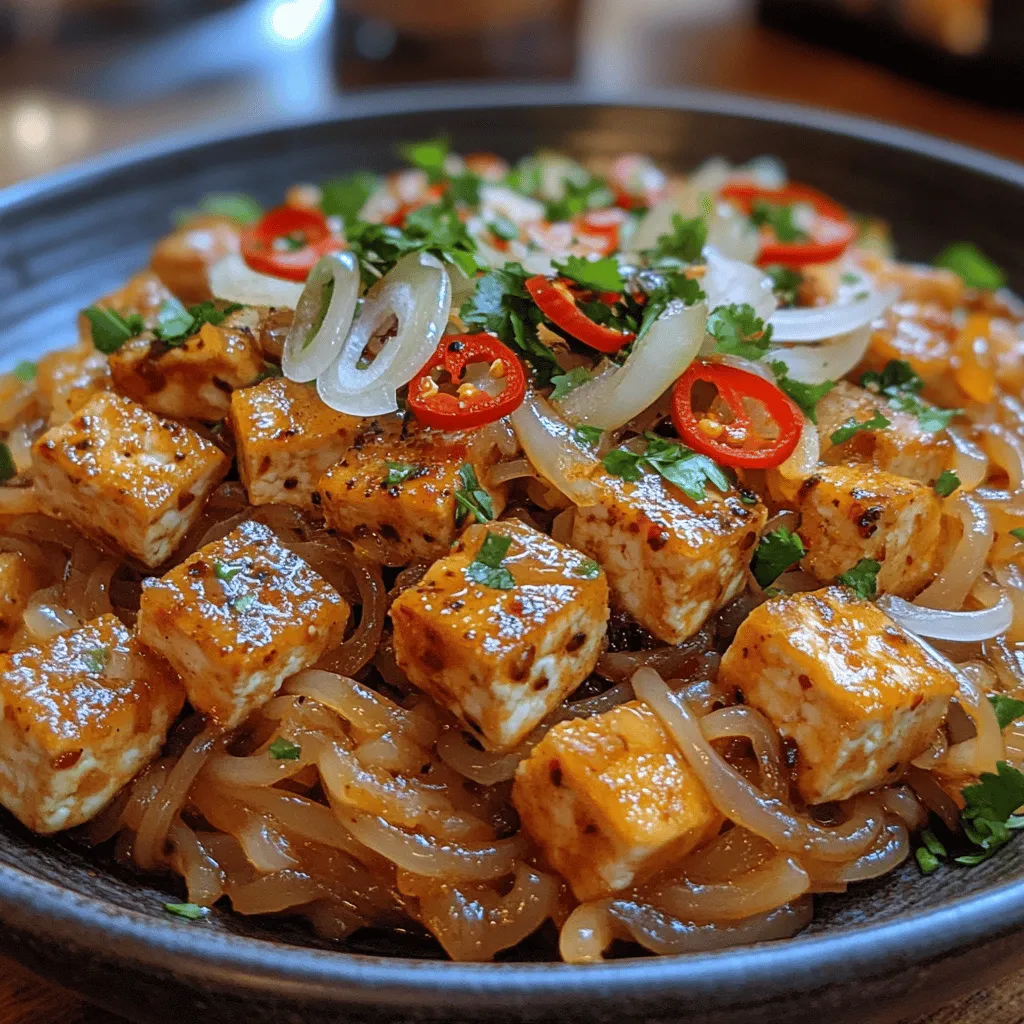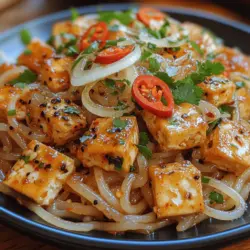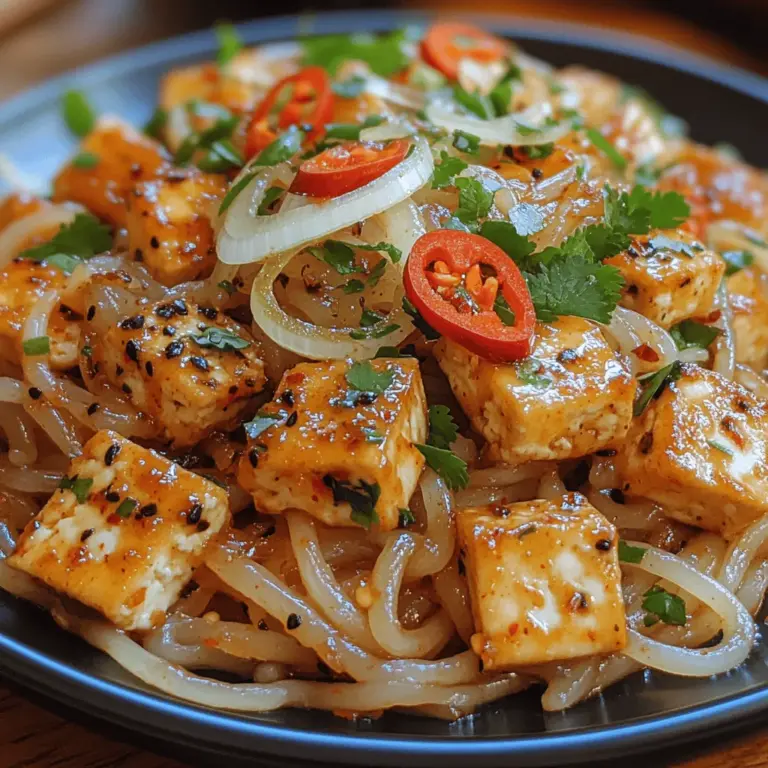Introduction
Chili Garlic Noodles with Crispy Tofu is a vibrant and satisfying dish that perfectly encapsulates the bold flavors and diverse textures characteristic of Asian cuisine. Noodle dishes have long been a staple in many cultures across Asia, prized for their versatility and ability to absorb flavors, making them an ideal canvas for a variety of ingredients. This particular recipe showcases the harmony between spicy, garlicky noodles and crispy, golden tofu, creating a meal that is not only delicious but also nourishing.
The appeal of this dish lies not just in its taste but also in its health benefits. Tofu, as a plant-based protein, provides essential amino acids while remaining low in calories, making it a favorite among health-conscious eaters and vegetarians alike. The combination of fresh garlic, ginger, and chili peppers not only enhances the dish’s flavor profile but also contributes to numerous health benefits, including anti-inflammatory properties and improved digestion. These ingredients work together to create a dish that is as beneficial as it is delectable.
In this article, we will guide you through the process of making Chili Garlic Noodles with Crispy Tofu, sharing tips and insights along the way to ensure your cooking experience is seamless and enjoyable.
Understanding the Ingredients
To truly appreciate the depth of flavors in Chili Garlic Noodles with Crispy Tofu, it is essential to understand the key ingredients that make this dish shine.
Noodles: Rice Noodles vs. Egg Noodles
The foundation of any noodle dish lies in the type of noodle used. In this recipe, you have the option of rice noodles or egg noodles. Rice noodles are gluten-free and have a delicate, chewy texture that absorbs sauces beautifully. They are typically used in many Southeast Asian dishes, such as Pad Thai and Pho. On the other hand, egg noodles, which contain egg and wheat, offer a richer flavor and a slightly firmer texture. Cooking times will vary between the two: rice noodles usually require a brief soak in hot water, while egg noodles need to be boiled until tender.
Fresh Garlic and Ginger: The Aromatic Duo
In Asian cooking, fresh garlic and ginger are indispensable. They provide a robust flavor base that elevates the overall taste of the dish. Garlic is known for its pungent aroma and health benefits, including immune-boosting properties. Ginger adds a warm, spicy note and is renowned for its digestive benefits. Using fresh garlic and ginger rather than powdered forms ensures maximum flavor and health benefits, making a significant difference in the dish’s final taste.
The Heat: Chili Peppers
Chili peppers are the star ingredient that adds heat and complexity to the dish. They come in various types, from mild to fiery, and can be used fresh, dried, or in paste form. For this recipe, crushed red pepper flakes or fresh chili slices can be added according to your heat preference. In addition to flavor, chili peppers are rich in vitamins A and C and can help boost metabolism, making them a useful addition to any dish.
Sauces: Soy Sauce, Oyster Sauce, and Mushroom Sauce
The choice of sauce can greatly impact the flavor of your noodles. Soy sauce is a classic choice, providing a salty umami flavor that balances out the heat from the chili peppers. For those who prefer a non-vegetarian option, oyster sauce adds a slightly sweet and savory depth to the dish. Alternatively, mushroom sauce is an excellent vegetarian substitute that offers a similar umami flavor without the use of animal products. Each sauce brings its unique characteristics, so feel free to experiment according to your dietary preferences.
Tofu: Nutritional Benefits and Selection
Tofu is a versatile protein source that plays a crucial role in this recipe, adding texture and substance. It is made from soybeans and is rich in protein, calcium, and iron while being low in calories. When choosing tofu for frying, opt for firm or extra-firm varieties, as they hold their shape better and develop a satisfying crunch when cooked. Pressing the tofu to remove excess moisture is essential for achieving that coveted crispy exterior, which we’ll explore in the next section.
Cooking Oils: Importance of Selection
The choice of cooking oil can also influence the dish’s flavor and health benefits. Vegetable oils, such as canola or peanut oil, are commonly used for frying due to their high smoke points and neutral flavors. These oils ensure that the tofu achieves a crispy texture without overwhelming the dish with additional flavors. For a more aromatic touch, you could consider using sesame oil, but be mindful of its lower smoke point and stronger flavor, which is best added at the end of cooking.
Preparing the Crispy Tofu
Achieving that perfect crispy tofu is a crucial step in making Chili Garlic Noodles with Crispy Tofu. Here’s how to prepare it properly.
Pressing Tofu: Methods and Benefits
Before frying, it is essential to press the tofu to eliminate excess moisture. This process allows the tofu to absorb more flavor and prevents it from becoming soggy during cooking. To press tofu, wrap it in a clean kitchen towel or paper towels, place it on a plate, and set a heavy object, such as a cast-iron skillet or a few cans, on top. Let it sit for at least 15-30 minutes. If you’re short on time, you can use a tofu press, which simplifies the process significantly.
Cutting and Seasoning Tofu
Once the tofu is pressed, cut it into bite-sized cubes or rectangles—about 1-inch in size works well for frying. In a mixing bowl, toss the tofu pieces with a bit of soy sauce, garlic powder, and a sprinkle of salt. This step infuses the tofu with flavor before frying, ensuring every bite is delicious.
Cornstarch Coating for Crispiness
To achieve that golden, crispy texture, coat the seasoned tofu in cornstarch. This coating helps create a barrier that locks in moisture while allowing the exterior to crisp up beautifully during frying. Simply place the cornstarch in a shallow dish and gently toss the tofu pieces in it until evenly coated. Shake off any excess cornstarch to avoid clumping.
Tips for Frying Tofu
When frying tofu, temperature is key. Heat a generous amount of vegetable oil in a non-stick skillet or wok over medium-high heat. To test if the oil is ready, drop a small piece of tofu into the oil—if it sizzles immediately, it’s time to fry. Fry the tofu in batches to avoid overcrowding the pan, which can lower the oil temperature and prevent proper crisping. Aim for a perfect golden brown on each side, which typically takes about 3-4 minutes per side. Once done, transfer the crispy tofu to a plate lined with paper towels to absorb any excess oil.
Cooking the Noodles
With the tofu ready, it’s time to focus on the noodles, the heart of this dish.
Noodle Cooking Process: Timing and Techniques
The cooking process for the noodles varies slightly depending on whether you choose rice or egg noodles. For rice noodles, bring a pot of water to a boil, then remove it from heat and add the noodles. Let them soak for about 7-10 minutes or until they are just tender, stirring occasionally to prevent sticking. Drain and rinse the noodles under cold water to stop the cooking process and remove excess starch, which can make them gummy.
For egg noodles, bring water to a rolling boil, add a pinch of salt, and cook the noodles according to package instructions, usually for about 4-6 minutes. Once cooked, drain and rinse with cold water as well. This step is crucial for both types of noodles, as it prevents them from clumping together and enhances their texture.
Importance of Rinsing Noodles After Cooking
Rinsing noodles after cooking is a practice that should not be overlooked. It helps to remove excess starch, which can cause the noodles to stick together. Additionally, rinsing cools down the noodles, making them easier to handle and allowing them to absorb the flavors of the sauce more effectively. This step ensures that every mouthful of Chili Garlic Noodles with Crispy Tofu is a harmonious blend of flavors and textures.
—
Stay tuned for the next part of this article, where we will dive into the final steps of combining all these elements into a delicious Chili Garlic Noodles with Crispy Tofu dish.

Suggestions for Alternative Noodle Options for Dietary Preferences
When it comes to crafting the perfect Chili Garlic Noodles with Crispy Tofu, the choice of noodles can greatly influence the dish’s texture and flavor. Luckily, there are several noodle options available to cater to various dietary preferences. Here are some alternatives to consider:
1. Gluten-Free Noodles: For those following a gluten-free diet, rice noodles or gluten-free pasta made from ingredients like quinoa or brown rice are excellent substitutes. They provide a similar texture and absorb flavors well, making them ideal for this recipe.
2. Whole Wheat Noodles: If you’re looking for a healthier alternative with more fiber, whole wheat noodles are a great option. They add a slightly nutty flavor and offer a nutritional boost compared to regular pasta.
3. Zucchini Noodles (Zoodles): For a low-carb, vegetable-based option, spiralized zucchini is a fantastic choice. While they won’t absorb the sauce as well, they add a fresh crunch and lighten the dish significantly.
4. Shirataki Noodles: Made from the konjac yam, these noodles are extremely low in calories and carbs, making them suitable for those on ketogenic or low-calorie diets. They have a unique texture and can soak up the chili garlic sauce effectively.
5. Soba Noodles: Another great option is buckwheat soba noodles, which are not only gluten-free but also rich in protein and fiber. Their earthy flavor pairs well with the spicy notes of the dish.
By selecting the right noodles for your dietary needs, you can enjoy Chili Garlic Noodles that not only satisfy your taste buds but also align with your nutritional goals.
Crafting the Chili Garlic Sauce
The heart of this dish lies in the flavorful chili garlic sauce. Mastering this sauce is essential for achieving the signature taste that makes these noodles irresistible.
1. Breakdown of the Sauce-Making Process:
Start by gathering your ingredients: minced garlic, grated ginger, red chili flakes, soy sauce, sesame oil, and a sweetener like agave syrup or honey. Heat a tablespoon of oil in a pan over medium heat, then add the minced garlic and grated ginger. Sauté them for about 30 seconds until fragrant, being careful not to let them brown, as this can lead to bitterness.
2. Techniques for Sautéing Garlic and Ginger:
The key to avoiding bitterness when sautéing garlic and ginger is to keep the heat moderate and stir frequently. If you notice the garlic starting to brown, reduce the heat immediately and add a splash of water or broth to cool the pan slightly. This technique helps maintain a sweet, aromatic flavor.
3. The Balance of Flavors:
Once the garlic and ginger are perfectly sautéed, add in the red chili flakes, soy sauce, and sesame oil. Each ingredient plays a crucial role: the garlic provides depth, the ginger adds warmth, while the chili flakes give the necessary heat. The soy sauce introduces umami, and the sesame oil contributes a nutty aroma.
4. Adjusting Spice Levels:
For those who prefer milder flavors, start with a smaller amount of red chili flakes, and gradually add more until you reach your desired heat level. Conversely, if you enjoy a spicy kick, feel free to increase the chili flakes or even add a dash of sriracha or chili paste for an extra layer of flavor.
Combining the Ingredients
Now that your sauce is ready, it’s time to bring everything together.
1. Step-by-Step Guide on Integrating the Noodles:
Once the noodles are cooked to your liking, drain them and add them directly to the pan with the chili garlic sauce. Use tongs or a spatula to gently toss the noodles, ensuring they are evenly coated in the sauce. This step is crucial as it allows the noodles to soak up the flavors.
2. Importance of Tossing Techniques:
When tossing the noodles, use a gentle folding motion rather than aggressive stirring. This technique prevents breakage and ensures that the noodles maintain their integrity while fully absorbing the sauce. Aim for a vibrant red color, which indicates that the sauce has coated the noodles well.
3. Visual Cues for Determining When the Dish is Ready:
The dish is ready when the noodles are heated through and have taken on the vivid color of the chili garlic sauce. Look for a slight sheen on the noodles, indicating they are well-coated. If desired, you can add a splash of reserved pasta water to loosen the sauce if it seems too thick.
Serving Suggestions
Presentation can elevate your Chili Garlic Noodles with Crispy Tofu from a simple meal to a delightful dining experience.
1. Presentation Tips for Plating the Dish:
To create an appealing plate, use a large, shallow bowl that allows the noodles to spread out. Twirl the noodles with tongs to create an attractive nest in the center of the bowl. This technique draws the eye and invites anticipation.
2. Garnishing Ideas:
Fresh herbs can make a significant difference in both flavor and presentation. Chopped green onions and cilantro sprinkled on top not only add a pop of color but also provide a fresh contrast to the rich flavors of the dish. A squeeze of lime juice can brighten the noodles and enhance the overall experience.
3. Pairing Recommendations:
For a well-rounded meal, consider serving these noodles with a light side salad or steamed vegetables. Pairing with a refreshing beverage, such as iced green tea or a light lager, can complement the dish’s flavors while providing a nice contrast.
Nutritional Information
Understanding the nutritional value of your meal is important for maintaining a balanced diet.
1. Breakdown of Calories, Macronutrients, and Vitamins:
A serving of Chili Garlic Noodles with Crispy Tofu typically contains around 450-500 calories, depending on the exact ingredients used. Protein from the tofu and carbohydrates from the noodles contribute to the macronutrient profile, which typically includes approximately 15-20 grams of protein, 60 grams of carbohydrates, and 15 grams of fat.
2. Discussion on Health Benefits:
This dish is rich in vitamins due to the fresh ingredients and provides a good balance of macronutrients. The addition of garlic and ginger can support immune health, while tofu offers a plant-based source of protein that is low in saturated fat.
3. Suggestions for Dietary Modifications:
For those on a low-carb diet, using zucchini noodles or shirataki noodles instead of traditional pasta can significantly reduce carbohydrate intake. Additionally, to make it vegan-friendly, ensure that any sweeteners used are plant-based.
Conclusion
Chili Garlic Noodles with Crispy Tofu is a delightful dish that perfectly balances flavor, nutrition, and convenience. With its vibrant spices and textures, it serves as a quick meal option that doesn’t compromise on taste or health benefits.
Encourage yourself to try making this dish at home, as it is not only simple to prepare, but it also allows for creativity in the kitchen. Experiment with different noodles, adjust the spice levels to your liking, and play around with various garnishes to make it your own.
The versatility of this recipe means it can be adapted to fit various dietary needs and taste preferences, offering endless possibilities for future cooking adventures. Whether you’re looking for a comforting weeknight dinner or a dish to impress guests, these Chili Garlic Noodles with Crispy Tofu will surely satisfy. Happy cooking!

